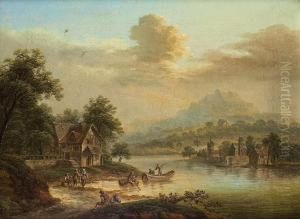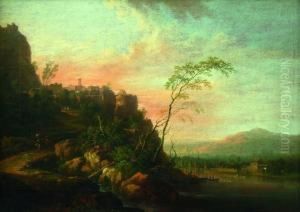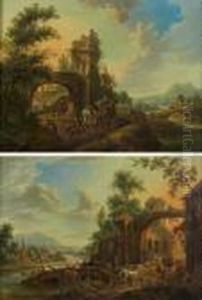Johann Georg Schutz Paintings
Johann Georg Schutz, born in 1755, was a German artist known for his contributions to the landscape painting genre, a field in which he carved a niche for himself within the European art scene of the late 18th and early 19th centuries. His work is often characterized by a vivid portrayal of nature, with a particular emphasis on the interplay of light and shadow, which adds a dramatic depth to his landscapes. Schutz's artistic journey was deeply influenced by the broader trends of the Romantic period, during which there was a growing emphasis on the emotional and the sublime aspects of nature.
Schutz's upbringing and early exposure to art played a crucial role in shaping his career. Details about his early life, such as his family background and initial art education, are sparse, but it is known that he was active in various German cities, where he was exposed to different artistic influences and circles. This period was crucial for his development as an artist, as he absorbed various stylistic elements that would later be reflected in his own work.
Throughout his career, Johann Georg Schutz was prolific, creating numerous landscapes that captured the diverse beauty of the natural world. His paintings often featured German countryside scenes, riverscapes, and forests, rendered with a meticulous attention to detail and a rich palette. Unlike some of his contemporaries, Schutz's work did not lean towards the fantastical elements of Romanticism but rather focused on the realistic and serene portrayal of nature.
Despite his contributions to the field of landscape painting, Johann Georg Schutz did not gain the same level of fame as some of his Romantic counterparts. However, his work has been appreciated for its technical skill and emotional depth, and it has been studied for its contribution to the development of landscape painting in Germany. Schutz passed away in 1813, leaving behind a legacy that has been appreciated by art historians and collectors alike.
In summary, Johann Georg Schutz's life and work offer a fascinating glimpse into the landscape painting of his time. His dedication to portraying the natural world with authenticity and emotional depth ensures his place within the canon of German Romantic artists, even if he remains less well-known than some of his peers.

















